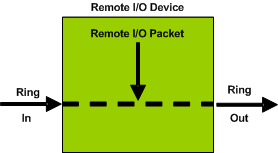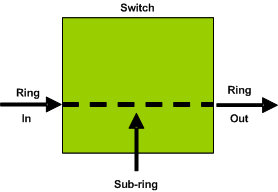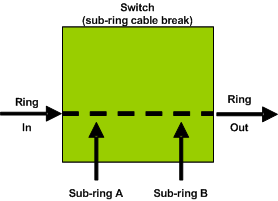|
Defined Architecture: Junctions
|
|
|
Original instructions
|

|
Time
|
Ring In
|
Remote I/O Packet
|
Ring Out
|
Comment
|
|---|---|---|---|---|
|
T0
|
1 (started)
|
a
|
|
packet a arrived after transmission of packet 1 begins
|
|
T1
|
2
|
|
1
|
packet 2 arrived after packet a
|
|
T2
|
3
|
|
a
|
packet 3 arrived after packet 2
|
|
T3
|
4
|
|
2
|
packet 4 arrived after packet 3
|
|
T4
|
5
|
|
3
|
packet 5 arrived after packet 4
|

|
Time
|
Ring In
|
Sub-ring
|
Ring Out
|
Comment
|
|---|---|---|---|---|
|
T0
|
1 (started)
|
a
|
|
packet a arrived after transmission of packet 1 begins
|
|
T1
|
2
|
b
|
1
|
packets 2 and b arrive simultaneously
|
|
T2
|
3
|
c
|
a
|
packets 3 and c arrive simultaneously
|
|
T3
|
4
|
d
|
2
|
packets 4 and d arrive simultaneously
|
|
T4
|
5
|
e
|
b
|
packets 5 and e arrive simultaneously
|

|
Time
|
Ring In
|
Sub-ring A
|
Sub-ring B
|
Ring Out
|
Comment
|
|---|---|---|---|---|---|
|
T0
|
1 (started)
|
a
|
p
|
|
packets a and p arrive after transmission of packet 1 begins
|
|
T1
|
2
|
b
|
q
|
1
|
packets 2 , b and q arrive simultaneously
|
|
T2
|
3
|
c
|
r
|
a
|
packets 3, c and r arrive simultaneously
|
|
T3
|
4
|
d
|
s
|
p
|
packets 4, d and s arrive simultaneously
|
|
T4
|
5
|
e
|
t
|
2
|
packets 5, e and t arrive simultaneously
|